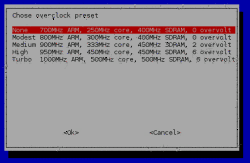The Raspberry Pi gets a turbo mode
 The Raspberry Pi Foundation has performed testing on the effects of overclocking and overvolting, and is now providing what it calls a "turbo mode" for the Raspberry Pi mini-computer. While the Foundation has always supported these kinds of modifications, they have in the past voided the customer's warranty for the product – a sticky bit in the BCM2835 chip makes sure this operation cannot be performed undetected. The turbo mode option enables users to get more performance out of their Raspberry Pis without having to be afraid of affecting their warranty.
The Raspberry Pi Foundation has performed testing on the effects of overclocking and overvolting, and is now providing what it calls a "turbo mode" for the Raspberry Pi mini-computer. While the Foundation has always supported these kinds of modifications, they have in the past voided the customer's warranty for the product – a sticky bit in the BCM2835 chip makes sure this operation cannot be performed undetected. The turbo mode option enables users to get more performance out of their Raspberry Pis without having to be afraid of affecting their warranty.
A new version of the raspi-config allows users to choose from five different overclocking presets, the highest of which runs the ARM processor of the device at a clock speed of 1GHz. The speed at which users will be able to stably overclock their Raspberry Pi depends on the quality of the power supply used. The Raspberry Pi foundation recommends running first-person shooter (FPS) game Quake 3 as a stress test. If users overclock at a level that does not work for their setup and the device will refuse to boot, holding down the Shift key during the boot process will temporarily disable overclocking for that boot.

![]() The Raspberry Pi can now be overclocked with five different speed levels
To be able to use turbo mode, users will have to update their installation of Raspbian to the latest version by invoking
The Raspberry Pi can now be overclocked with five different speed levels
To be able to use turbo mode, users will have to update their installation of Raspbian to the latest version by invoking sudo apt-get update && sudo apt-get upgrade from the command line. The new version of the distribution also adds two panel applets to the LXDE environment that show the current temperature and clock speed of the CPU. A newly implemented Wi-Fi control interface enables the user to configure wireless adapters without having to install additional software.
According to benchmarking done by the foundation, the new turbo mode at the highest setting was up to 52 per cent faster at 1GHz than the previous Raspbian image at the standard 700MHz. The overclocking is performed dynamically so that the turbo mode only gets enabled when the processor is actually under load. Additionally, any overclocking is disabled if the chip exceeds a temperature of 89°C. According to the tests run by the developers this prevents the turbo mode from having adverse effects on the chip's lifetime.
The latest version of Raspbian is available from the distribution's web site which also maintains documentation for the project.
(fab)
![Kernel Log: Coming in 3.10 (Part 3) [--] Infrastructure](/imgs/43/1/0/4/2/6/7/2/comingin310_4_kicker-4977194bfb0de0d7.png)

![Kernel Log: Coming in 3.10 (Part 3) [--] Infrastructure](/imgs/43/1/0/4/2/3/2/3/comingin310_3_kicker-151cd7b9e9660f05.png)
















